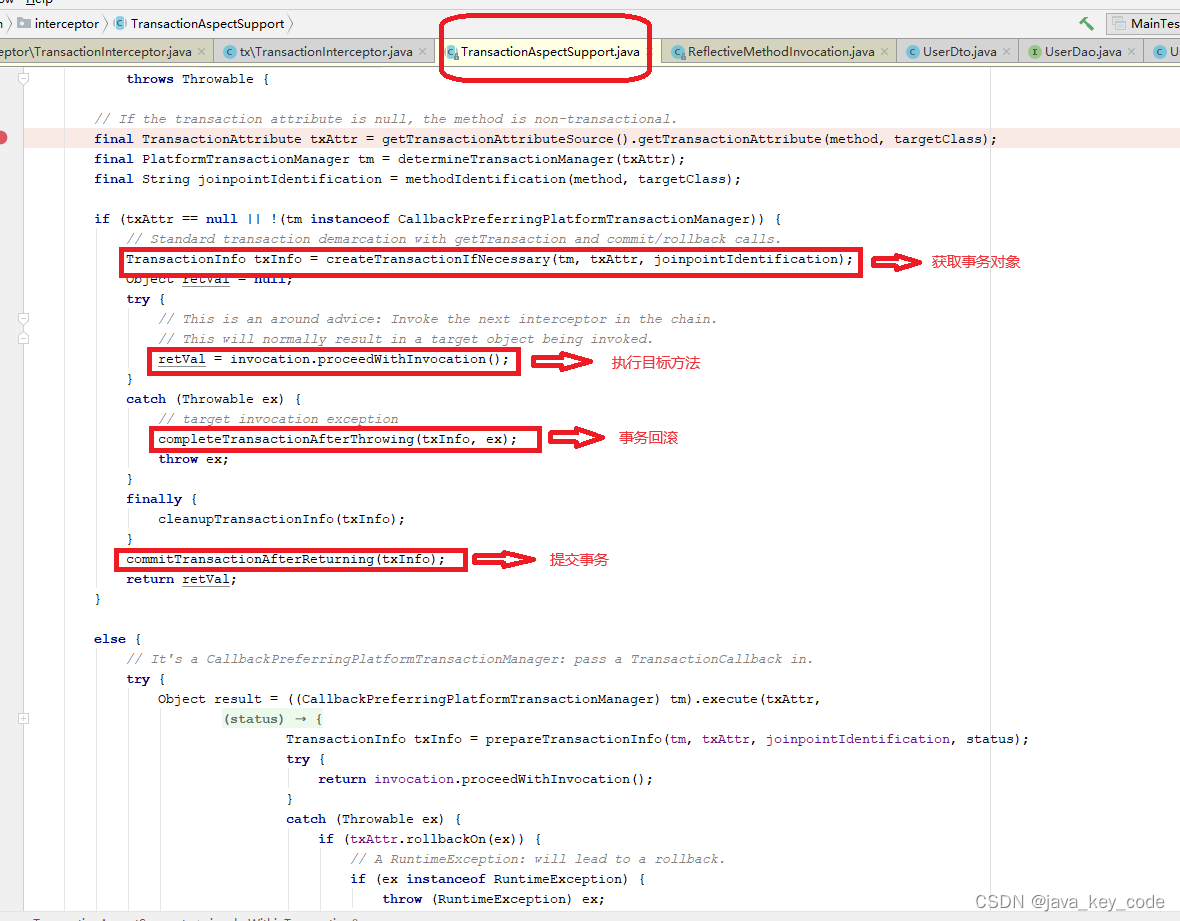了解了Spring AOP執行過程,再看Spring事務源碼其實非常簡單。
首先從簡單使用開始, 演示Spring事務使用過程
Xml配置:
<?xml version="1.0" encoding="UTF-8"?>
<beans xmlns="http://www.springframework.org/schema/beans"xmlns:xsi="http://www.w3.org/2001/XMLSchema-instance"xmlns:aop="http://www.springframework.org/schema/aop"xmlns:tx="http://www.springframework.org/schema/tx"xsi:schemaLocation="http://www.springframework.org/schema/beans http://www.springframework.org/schema/beans/spring-beans.xsdhttp://www.springframework.org/schema/aop http://www.springframework.org/schema/aop/spring-aop.xsdhttp://www.springframework.org/schema/tx http://www.springframework.org/schema/tx/spring-tx.xsd"><!-- 數據庫連接池 --><bean id="dataSource" class="com.alibaba.druid.pool.DruidDataSource" destroy-method="close"><property name="url" value="jdbc:mysql:///custom_db" /><property name="username" value="root" /><property name="password" value="123456" /><property name="driverClassName" value="com.mysql.jdbc.Driver" /></bean><!-- JdbcTemplate 對象 --><bean id="jdbcTemplate" class="org.springframework.jdbc.core.JdbcTemplate"><property name="dataSource" ref="dataSource"></property></bean><!-- transactionManager 對象 --><bean id="transactionManager" class="org.springframework.jdbc.datasource.DataSourceTransactionManager"><property name="dataSource" ref="dataSource"></property></bean><tx:advice id="txAdvice" transaction-manager="transactionManager"><tx:attributes><tx:method name="*" propagation="REQUIRED"/></tx:attributes></tx:advice><aop:config><aop:advisor advice-ref="txAdvice" pointcut="execution(* org.spring.tx.dao.*.*(..))"></aop:advisor></aop:config><bean id="userDao" class="org.spring.tx.dao.UserDaoImpl"><constructor-arg index="0" ref="jdbcTemplate"></constructor-arg></bean></beans>實體類:
package org.spring.tx.dto;public class UserDto {private Long id;private String UserName;public Long getId() {return id;}public void setId(Long id) {this.id = id;}public String getUserName() {return UserName;}public void setUserName(String userName) {UserName = userName;}
}業務Dao類:
package org.spring.tx.dao;import org.spring.tx.dto.UserDto;public interface UserDao {void insert(UserDto userDto);
}package org.spring.tx.dao;import org.spring.tx.dto.UserDto;
import org.springframework.jdbc.core.JdbcTemplate;public class UserDaoImpl implements UserDao {//注入 JdbcTemplateprivate JdbcTemplate jdbcTemplate;public UserDaoImpl(JdbcTemplate jdbcTemplate) {this.jdbcTemplate = jdbcTemplate;}@Overridepublic void insert(UserDto userDto) {//創建 sql 語句String sql = "insert into user (username)values(?)";//調用方法實現Object[] args = {userDto.getUserName()};//返回影響行數int update = jdbcTemplate.update(sql,args);System.out.println("user新增條數:" + update);//throw new RuntimeException("業務出錯了!!!");}
}測試代碼:
package org.spring.tx;import org.spring.tx.dao.UserDao;
import org.spring.tx.dto.UserDto;
import org.springframework.context.support.ClassPathXmlApplicationContext;public class MainTest {public static void main(String[] args) {ClassPathXmlApplicationContext applicationContext = new ClassPathXmlApplicationContext("spring-tx.xml");applicationContext.start();UserDao userDao = applicationContext.getBean(UserDao.class);UserDto userDto = new UserDto();userDto.setUserName("zhangsan");userDao.insert(userDto);applicationContext.stop();}
}執行結果:

==================從源碼角度簡單分析一下=====================
根據Spring AOP過程(參考:Spring AOP源碼篇二之 代理工廠ProxyFactory學習-CSDN博客??Spring AOP源碼篇三之 xml配置-CSDN博客),增強工作由Advice完成,而事務的Advice對應的是TransactionInterceptor.
public class TransactionInterceptor extends TransactionAspectSupport implements MethodInterceptor, Serializable {public TransactionInterceptor() {}public TransactionInterceptor(PlatformTransactionManager ptm, Properties attributes) {setTransactionManager(ptm);setTransactionAttributes(attributes);}public TransactionInterceptor(PlatformTransactionManager ptm, TransactionAttributeSource tas) {setTransactionManager(ptm);setTransactionAttributeSource(tas);}//TransactionInterceptor實現了Advice(MethodInterceptor)接口,增強工作由該方法完成//核心代碼,方法調用入口public Object invoke(final MethodInvocation invocation) throws Throwable {Class<?> targetClass = (invocation.getThis() != null ? AopUtils.getTargetClass(invocation.getThis()) : null);// 父類TransactionAspectSupport中方法return invokeWithinTransaction(invocation.getMethod(), targetClass, new InvocationCallback() {public Object proceedWithInvocation() throws Throwable {return invocation.proceed();}});}//---------------------------------------------------------------------// Serialization support//---------------------------------------------------------------------private void writeObject(ObjectOutputStream oos) throws IOException {// Rely on default serialization, although this class itself doesn't carry state anyway...oos.defaultWriteObject();// Deserialize superclass fields.oos.writeObject(getTransactionManagerBeanName());oos.writeObject(getTransactionManager());oos.writeObject(getTransactionAttributeSource());oos.writeObject(getBeanFactory());}private void readObject(ObjectInputStream ois) throws IOException, ClassNotFoundException {// Rely on default serialization, although this class itself doesn't carry state anyway...ois.defaultReadObject();// Serialize all relevant superclass fields.// Superclass can't implement Serializable because it also serves as base class// for AspectJ aspects (which are not allowed to implement Serializable)!setTransactionManagerBeanName((String) ois.readObject());setTransactionManager((PlatformTransactionManager) ois.readObject());setTransactionAttributeSource((TransactionAttributeSource) ois.readObject());setBeanFactory((BeanFactory) ois.readObject());}}





)
)









【分布式事務和兩階段提交協議】)


